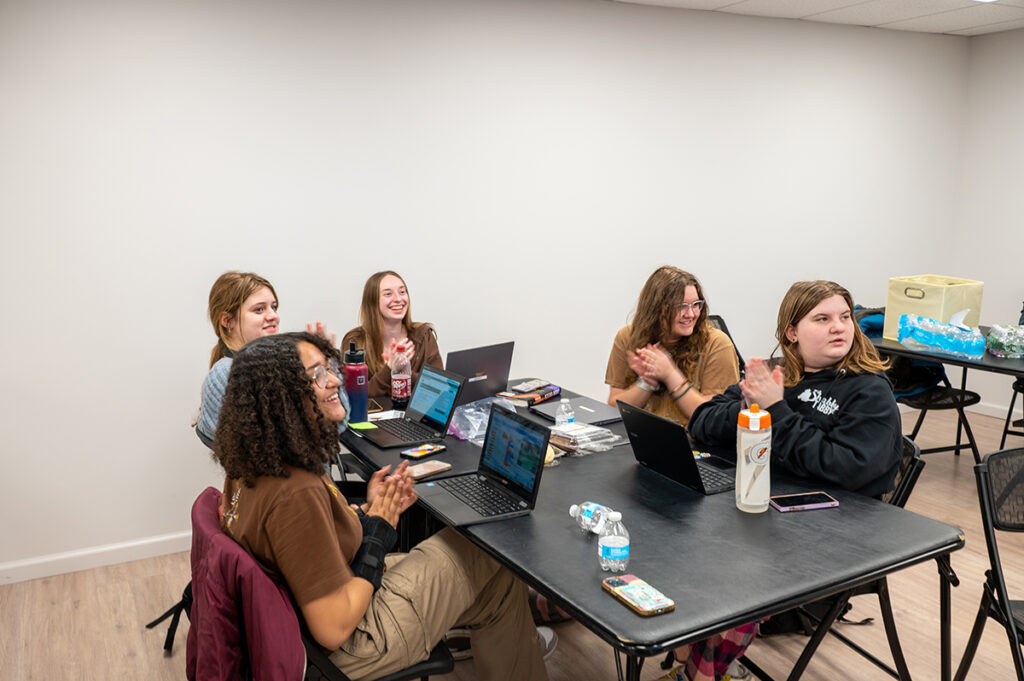Local student launches Girls Who Code club at Mattituck-Laurel Library

Last month, Mattituck High School junior Paulina Cubie launched a Girls Who Code club at Mattituck-Laurel library.
The extracurricular program is part of a nationwide non-profit campaign that seeks to close the gender gap in science, technology, engineering and math (STEM) education by providing young women with resources and services to learn how to write computer code.
Paulina, who goes by the nickname “Lina,” noted that she still has seven open seats in her program, and that the club is open to any high school or junior high school girl — not just Mattituck students.
The club meets for one hour a week for 10 weeks. Each session uses presentations and short videos provided by the Girls Who Code national office and begins with a sisterhood activity designed to encourage team building.
Toward the end of this semester’s program, the Mattituck-Laurel club will develop a final project. The group chose to focus on their local environment, and are planning to create a website, an app or a game that addresses the impacts of climate change on their East End communities.
“A lot of us have seen different [environmental] impacts that really aren’t talked about a lot with our peers,” Lina said. “We’re really focused on raising that awareness in this small community.”
She launched her chapter of Girls Who Code, she said, after growing tired of being the sole girl in engineering classes.

The need for more girls who code is borne out in a 2022 report released by the National Science Board, an independent agency that advises the federal government on policy matters related to science and engineering. The report found that “in 2019, women accounted for 48% of life scientists and 65% of social scientists but only 35% of physical scientists, 26% of computer and mathematical scientists, and 16% of engineers.”
The national Girls Who Code organization, founded in 2012, includes more than half a million current students and about 115,000 alumni, according to the national office.
Lina said she aims to help women of her generation enter careers in the physical sciences, the tech industry and engineering.
“I just want there to be more encouragement to go into this because it’s intimidating to go into a field where it’s mostly guys and guys run it,” she said. “I want there to be a space where you can just have fun learning about this and find this passion — if you’re interested or not — without all the external factors … You shouldn’t have to prove yourself or anything like that.”
Lina, 17, learned firsthand about some of the ways gender impacts teens who are curious about science and engineering. During middle school, she was assigned to be the “notebook girl” on her robotics team.
“I had the pretty handwriting so I was the one assigned to take the notes,” she explained. “I liked it, but mostly I was there to make a robot, so I would step in when people were messing around or not doing their job.”
When her robotics team traveled to competitions, Lina met other girls who had had similar experiences of being relegated to secretarial duties such as taking notes in their own STEM classes. She said that Girls Who Code provides her and her peers with a space for like-minded young women and encourages them to create on their own terms.
After only a month, the new club already seems to be having an impact.
“When I saw Lina was opening up a club that would teach us more about how to make games that we like and we didn’t have to do the stuff the school forced us to do, I was really excited,” said club member Tiffany Zambito. “Plus it’s with people my age that are my friends.”
At a recent meeting of the club, the camaraderie among the students was obvious as Lina, Tiffany and their friends put their coding skills to the test using Scratch, an educational coding program. Munching on cookies and calling out music requests (which ranged from the “Mission Impossible” theme to a Beach Boys deep cut), they would help each other work through the technological process and play each other’s games, trying their best to click on the cartoon frogs and Garfields as they skipped across their computer screens.
In recent weeks, the girls have been learning a process called “block coding,” which is an introductory, drag-and-drop version of coding to create simple digital games online. By the end of the course, club members will be prepared for more sophisticated coding.
While Lina is keen on adding coding to her engineering tool belt, she also hopes to combine technology with her other passion: the arts. Her prowess in math and science is balanced by a love of dancing and creating artwork.
She said that a recent educational excursion to Disney World opened her eyes to the coding behind the magic of Disney. She met with Imagineers, the research and development team that designs and builds the theme park’s attractions, combining various passions and skills just as Lina hopes to someday.
“It interests me, finding new ways to impact people and the world through technology,” she said. “Coding is an innovation that keeps growing with the times. When I’m an adult, I want to be able to keep working through that medium.”








